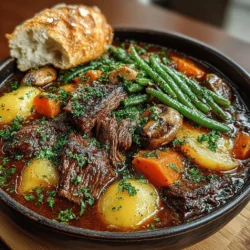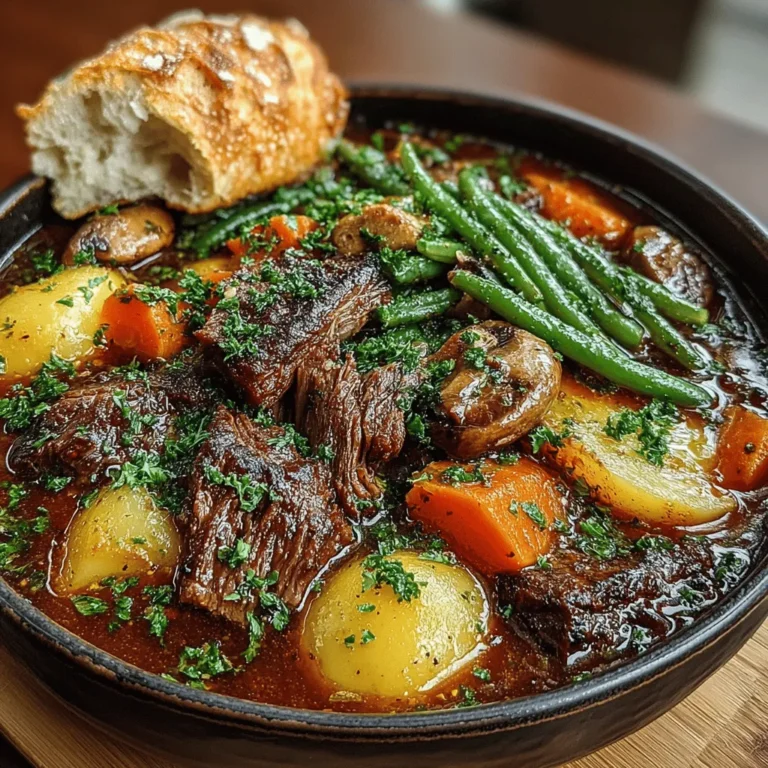Introduction
As the leaves turn vibrant shades of orange and gold and the crisp air settles in, there’s a particular comfort that comes with the season of fall. One of the quintessential dishes that embodies the warmth of autumn is beef stew. This hearty meal not only provides nourishment but also evokes feelings of home, tradition, and togetherness. The slow-simmering flavors meld together, creating a dish that envelops you in its rich aroma and satisfying taste.
The Rustic Harvest Beef Stew is an ideal choice for this time of year, showcasing the beauty of seasonal ingredients while delivering a depth of flavor that warms the soul. This recipe is not just a meal; it is a celebration of the harvest season, highlighting the bounty of fresh vegetables and the robust flavors of tender beef. As you gather around the table with family and friends, this stew serves as a reminder of the cozy moments shared during the cooler months.
Understanding the Ingredients
To craft the perfect Rustic Harvest Beef Stew, understanding the role of each ingredient is essential. Each element contributes to the overall taste, texture, and nutritional value of the dish.
Beef Chuck Roast
The star of any beef stew is, of course, the meat. For this recipe, beef chuck roast is the ideal choice. Known for its rich flavor and melt-in-your-mouth tenderness, chuck roast becomes exceptionally tender when slow-cooked. The marbling of fat within the meat breaks down during the cooking process, infusing the stew with a deep, beefy flavor that is both satisfying and hearty. Additionally, the robust nature of chuck roast holds up well against the other ingredients, making it a perfect centerpiece for this rustic dish.
Vegetables
The addition of seasonal vegetables not only enhances the flavor of the stew but also boosts its nutritional profile. This recipe calls for:
– Carrots: Their natural sweetness balances the savory elements of the stew.
– Potatoes: Providing a hearty texture, potatoes help to thicken the broth while adding comfort.
– Mushrooms: Their earthy flavor complements the beef, lending a depth that is reminiscent of the forest floor.
– Butternut Squash: With its slight sweetness, butternut squash introduces a seasonal flair and a rich, creamy texture.
– Green Beans: These add a pop of color and a fresh crunch, brightening the dish with their vibrant green hues.
Each vegetable not only contributes to the stew’s flavor but also packs in essential vitamins and minerals, making the dish as nutritious as it is delicious.
Aromatics
No stew is complete without the foundational flavors provided by aromatics like onion and garlic. Sautéing these ingredients at the beginning of the cooking process releases their natural oils and flavors, creating a fragrant base that enhances the entire dish. Onions bring a subtle sweetness, while garlic adds a savory punch, making them an essential duo in building the flavor profile of the stew.
Seasonings and Liquids
To elevate the stew further, a combination of seasonings and liquids is crucial. The base of the broth is created with beef broth, which provides a robust backdrop for the other ingredients. Tomato paste contributes a touch of acidity and a rich color, while Worcestershire sauce introduces a complex, umami flavor that ties all the elements together. Together, these components create a savory and well-balanced broth that envelops the ingredients in warmth and depth.
Step-by-Step Cooking Process
Creating the Rustic Harvest Beef Stew involves a few essential steps that ensure maximum flavor and tenderness. By following these steps, you’ll be able to develop a dish that not only tastes incredible but also fills your kitchen with enticing aromas.
Searing the Beef
The first step in the cooking process is to sear the beef. This important technique enhances the overall flavor of the stew by creating a caramelized crust on the meat. When searing, it’s vital to use a heavy-bottomed pot or Dutch oven and to preheat it properly. A hot surface allows the beef to brown quickly, preventing it from steaming and ensuring that it develops a rich, deep color.
For effective searing, cut the beef into large chunks and season it generously with salt and pepper. Avoid overcrowding the pot; sear the meat in batches if necessary to maintain the high temperature. This initial step not only locks in moisture but also adds layers of flavor that will permeate the entire stew.
Sautéing Aromatics
Once the beef is seared and set aside, it’s time to sauté the aromatics. Using the same pot allows you to capture the flavorful bits left behind from the beef, which contributes to the overall depth of the stew. Begin by adding finely chopped onions and minced garlic to the pot, stirring frequently until the onions are translucent and fragrant. This process usually takes about 5 minutes, and it’s crucial to pay attention to avoid burning the garlic, as it can become bitter.
The softened onions and garlic create a flavorful foundation that will permeate the stew, enhancing every bite with their rich essence.
Layering Vegetables
With the aromatics ready, it’s time to layer in the vegetables. Begin by adding the carrots, potatoes, and butternut squash, stirring them into the pot to coat them with the aromatic mixture. This initial sauté helps to release their natural sugars, further enhancing the flavors. After a few minutes, incorporate the mushrooms and green beans, allowing them to soften slightly before adding the liquids.
Layering the vegetables not only adds visual appeal but also ensures even cooking. By placing sturdier vegetables like potatoes and carrots at the bottom, they receive the most heat and cook thoroughly, while more delicate vegetables like green beans can maintain their texture.
Mixing Liquids and Spices
Finally, it’s time to create the broth that will bring everything together. Pour in the beef broth, scraping the bottom of the pot to release any browned bits. Add tomato paste and Worcestershire sauce, stirring until fully combined. Season with herbs and spices according to your preference—thyme, bay leaves, and pepper are excellent choices that complement the flavors of the beef and vegetables.
As the stew simmers, the liquids will meld with the ingredients, creating a rich and hearty broth that warms the body and soul.
With these initial steps, the foundation for your Rustic Harvest Beef Stew is set. The combination of quality ingredients and careful preparation will lead to a comforting dish that embodies the essence of fall. As the stew cooks slowly, the kitchen will fill with delightful aromas, enticing everyone to gather around the table for a nourishing meal that celebrates the season.
{{image_2}}
Combining in the Slow Cooker
Once you’ve prepared all your ingredients, it’s time to bring them together in the slow cooker. This step is crucial for ensuring an even distribution of flavors, which is the hallmark of any great stew.
1. Layering Ingredients: Begin by placing the beef cubes at the bottom of the slow cooker. This allows the meat to absorb the rich flavors from the broth and vegetables above it. Next, add your chopped root vegetables—such as carrots, potatoes, and parsnips—followed by the onions and garlic.
2. Adding Seasonings: Sprinkle the herbs and spices over the vegetables. This ensures that the seasoning permeates every layer of the stew as it cooks.
3. Pouring the Liquid: Finally, pour in your beef broth or stock. Make sure to cover the ingredients adequately, but don’t overfill the cooker. A good rule of thumb is to fill it no more than two-thirds full to allow for bubbling and expansion during cooking.
Cooking Methods and Timing
When it comes to cooking your Rustic Harvest Beef Stew, you have two primary methods: slow cooking and fast cooking. Each has its unique benefits, and the choice often depends on your schedule and preference.
Slow Cooking vs. Fast Cooking
– Slow Cooking: This method is ideal for developing deep, rich flavors. Cooking on low for 8 hours or on high for 4 to 5 hours allows the collagen in the beef to break down, resulting in tender meat and a luscious broth. The slow cooking process also melds the flavors of the ingredients beautifully, creating a well-rounded dish.
– Fast Cooking: If you’re short on time, you can opt for a pressure cooker. This method can cut the cooking time significantly, allowing you to enjoy your stew in about 1 to 1.5 hours. While the flavors may not be as deeply developed as in slow cooking, pressure cooking still yields a tender beef stew.
Recommended Cooking Times and Temperatures
For optimal results, follow these general cooking times based on your method:
– Slow Cooker (Low): 8 hours
– Slow Cooker (High): 4-5 hours
– Pressure Cooker: 35-45 minutes
Visual Cues for Doneness
As your stew cooks, pay attention to the visual cues indicating it’s ready to serve:
– Beef Tenderness: The beef should be fork-tender, meaning it easily pulls apart with a fork.
– Vegetable Texture: The vegetables should be soft but not mushy, retaining their shape while being fully cooked.
Tips for Serving and Pairing
Presenting your Rustic Harvest Beef Stew can elevate the dining experience. Here are some tips to make your dish visually appealing and deliciously complemented.
Presentation
1. Serving Dish: Choose a rustic bowl or deep plate that highlights the stew’s rich colors.
2. Garnishing: Consider garnishing with fresh herbs such as parsley or thyme for a pop of color and added freshness. A sprinkle of freshly cracked black pepper can also enhance the visual appeal.
Side Dish Pairings
To round out the meal, consider serving your stew with these complementary side dishes:
– Crusty Bread: A warm, crusty baguette or sourdough bread is perfect for dipping into the broth.
– Salads: A light green salad with a simple vinaigrette can provide a refreshing contrast to the hearty stew.
– Roasted Vegetables: Offer a side of seasonal roasted vegetables for added texture and flavor.
Beverage Pairings
The right beverage can enhance your meal experience significantly:
– Wines: A full-bodied red wine, such as a Cabernet Sauvignon or a Merlot, pairs beautifully with the rich flavors of the stew.
– Seasonal Drinks: For a non-alcoholic option, consider serving a spiced apple cider or a pumpkin-flavored beverage to complement the fall theme of the dish.
Nutritional Value and Health Benefits
Understanding the nutritional value of your Rustic Harvest Beef Stew can further enhance its appeal. Here’s a breakdown of the health benefits of the primary ingredients used:
– Protein Content from Beef: Beef is an excellent source of high-quality protein, essential for muscle repair and growth. It also provides important nutrients like iron and zinc, which are vital for overall health.
– Fiber and Vitamins from Vegetables: The root vegetables included in this stew, such as carrots, potatoes, and parsnips, provide dietary fiber, helping to support digestive health. They are also rich in vitamins A and C, which are essential for maintaining a strong immune system.
– Benefits of a Hearty Stew in a Balanced Diet: A hearty stew like this not only warms you up but also offers a balanced meal option. The combination of protein, fiber, and vitamins creates a comforting dish that can be part of a healthy diet, especially during the cooler months.
Conclusion
In summary, Rustic Harvest Beef Stew is more than just a meal; it’s a heartwarming dish that encapsulates the essence of comfort food. Its nourishing qualities make it a perfect choice for family gatherings or cozy dinners during the fall season. The process of making this stew encourages you to embrace seasonal cooking and the joy of preparing a meal that brings everyone together.
As you gather around the table, savoring each bite of this rich and flavorful stew, you’ll create lasting memories with loved ones. So grab your ingredients, follow the steps, and experience the warmth and joy of Rustic Harvest Beef Stew in your home. Enjoy the process, and don’t forget to share your culinary creations with family and friends!


